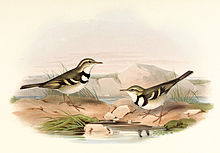കാട്ടു വാലുകുലുക്കി
| കാട്ടു വാലുകുലുക്കി (Forest Wagtail) | |
|---|---|

| |
| ശാസ്ത്രീയ വർഗ്ഗീകരണം | |
| കിങ്ഡം: | |
| Phylum: | |
| Class: | |
| Order: | |
| Family: | Motacillidae
|
| Genus: | Dendronanthus Blyth, 1844
|
| Species: | D. indicus
|
| Binomial name | |
| Dendronanthus indicus (Gmelin, 1789)
| |
| Synonyms | |
|
Limonidromus indicus | |
കാട്ടുവാലുകുലുക്കിയുടെ[2] [3][4][5] ആംഗലനാമം Forest Wagtail എന്നും ശാസ്ത്രീയ നാമം Dendronanthus indicus എന്നുമാണ്.
ദേശാടനക്കാരായ ഈ വാലുകുലുക്കികൾ കാട്ടിൽ വസിക്കുന്നവരാണ്. ചിറകിലെ കറുപ്പും വെളുപ്പും ഇടകലർന്ന സീബ്രാവരകൾ ആണ് ഇവയെ തിരിച്ചറിയാൻ സഹായിക്കുന്നത്. മറ്റുവാലുകുലുക്കികളിൽ നിന്ന് വ്യത്യസ്തമായി ഈ പക്ഷിയുടെ വാലിന്റെ ചലനം. ഇടത്തുനിന്ന് വലത്തോട്ടാണ്. കാട്ടുപാതകളിൽ ചടുലതയോടെ ഓടിനടക്കുന്നത് കാണാം. മരത്തിൽ കയറി പ്രാണികളെ പിടിയ്ക്കുന്നതിലും ഇവ മിടുക്കരാണ്. ഏപ്രിൽ മാസത്തോടെയാണ് ഇവ കൂടുകൂട്ടാൻ ഇന്ത്യയുടെ വടക്കു കിഴക്കൻ പ്രദേശങ്ങളിൽ പോകുന്നു. സെപ്റ്റംബർ മാസത്തോടെ ഇവ കേരളത്തിലേയ്ക്ക് ദേശാടനത്തിനെത്തുന്നു.
വിവരണം

18 സെ.മീ നീളം. വലിയ വാൽ. മുകൾഭാഗവും തൊപ്പിയും ഒലീവ് തവിട്ടു നിറം. അടിവശം വെള്ളയാണ്. നെഞ്ചിൽ രണ്ടു കറുത്ത വരകളുണ്ട്. ചിറക് കറുപ്പാണ്. ചിറകിൽ രണ്ടു മഞ്ഞ വരകളുണ്ട്. .[6]
വിതരണം
കിഴക്കൻ ഏഷ്യ, കൊറിയയുടെ ഭാഗങ്ങൾ, ചൈനയുടെ ഭാഗങ്ങൾ, സൈബീരിയയുടെ ഭാഗങ്ങൾ എന്നിവിടങ്ങളിൽ പ്രജനനം നടത്തുന്നു. തണുപ്പുകാലത്ത് ആന്തമാൻ ദ്വീപുകൾ വഴി തെക്കെഇന്ത്യ, ശ്രീലങ്ക എന്നിവിടങ്ങളിൽ എത്തുന്നു. [7]
ഭക്ഷണം

ഇവ ഒറ്റയ്ക്കും കൂട്ടായും കാണുന്നു. മരങ്ങളിൽ നിന്നും പ്രാണികളെ പിടിക്കുന്നു. നിലത്തും ഇര തേടാറുണ്ട്. .[8] [9]ഇവയ്ക്ക് മരത്തിന്റെ കുത്ത്നെയുള്ള ശാഖകളിൽ കയറാനും തിരശ്ചീനമായ ശഖകളിൽ ഓടാനും പറ്റും. [7]
പ്രജനനം
കോപ്പയുടെ ആകൃതിയിലുള്ള കൂട് പിടയാണ് ഉൻടാക്കുന്നത്. പൂവൻ കാവൽ നിൽക്കുകയേ ഉള്ളു. അഞ്ചു മുട്ടകളാണ് ഇടുന്നത്. പിടയാണ് അടയിരിക്കുന്നത്. 13-15 ദിവസം കൊണ്ട് മുട്ട വിരിയും. [8][7][10]
അവലംബം
- ↑ "Dendronanthus indicus". IUCN Red List of Threatened Species. Version 2008. International Union for Conservation of Nature. 2008. Retrieved 29 November 2010.
{cite web}: Cite has empty unknown parameter:|last-author-amp=(help); Invalid|ref=harv(help); Unknown parameter|authors=ignored (help) - ↑ J, Praveen (17 November 2015). "A checklist of birds of Kerala, India". Journal of Threatened Taxa. 7 (13): 7983–8009. doi:10.11609/JoTT.2001.7.13.7983-8009.
- ↑ "eBird India- Kerala". eBird.org. Cornell Lab of Ornithology. Retrieved 24 സെപ്റ്റംബർ 2017.
- ↑ കെ.കെ., നീലകണ്ഠൻ (2017). കേരളത്തിലെ പക്ഷികൾ (5 ed.). കേരള സാഹിത്യ അക്കാദമി. p. 505. ISBN 978-81-7690-251-9.
{cite book}:|access-date=requires|url=(help) - ↑ Grimmett, Richard; Inskipp, Tim; P.O., Nameer (2007). Birds of Southern India [Thekke Indiayile Pakshikal (Malayalam version)]. Mumbai: BNHS.
{cite book}:|access-date=requires|url=(help) - ↑ Baker, E C Stuart (1926). The Fauna of British India, Including Ceylon and Burma. Birds. Volume 3 (2 ed.). pp. 275–277.
- ↑ 7.0 7.1 7.2 Neufeldt, Irene (1961). "The breeding biology of the Forest Wagtail, Motacilla indica Gmelin". Journal of the Bombay Natural History Society. 58 (3): 559–588.
- ↑ 8.0 8.1 Ali, S. & S.D.Ripley (1998). Handbook of the Birds of India and Pakistan. Volume 9 (2 ed.). New Delhi: Oxford University Press. pp. 277–280.
- ↑ Hoffmann, A (1952). "Ueber den Gesang der Indischen Baumstelze Dendronanthus indicus (Gmelin)". Bonner Zool. Beitr. (in ജർമ്മൻ). 1–2 (3): 11–16.
- ↑ Austin, O L (1948). "The birds of Korea". Bulletin of the museum of comparative zoology. 101: 1–302.
